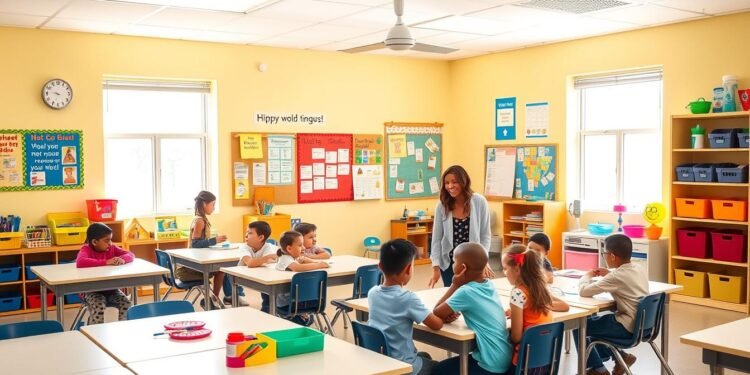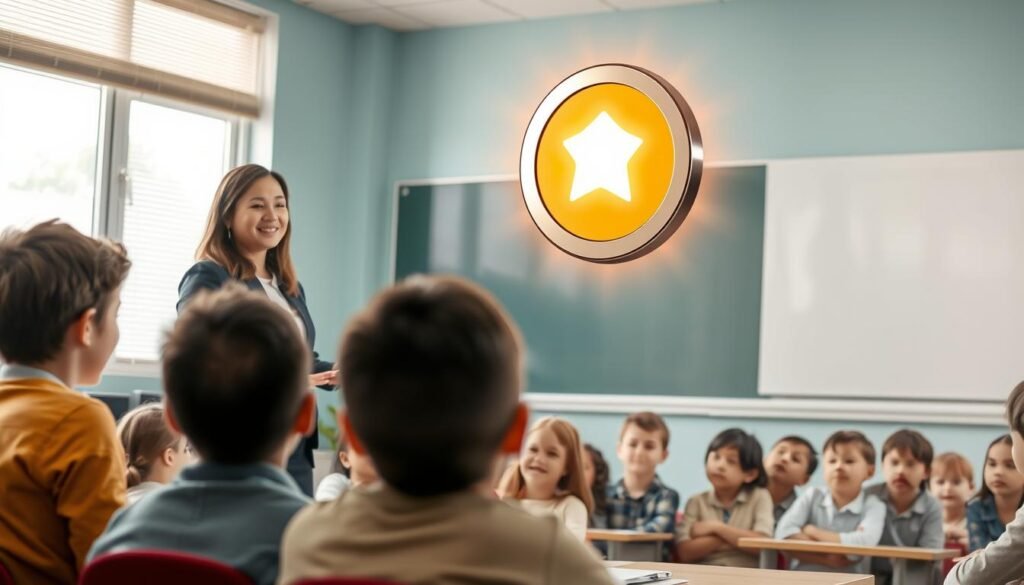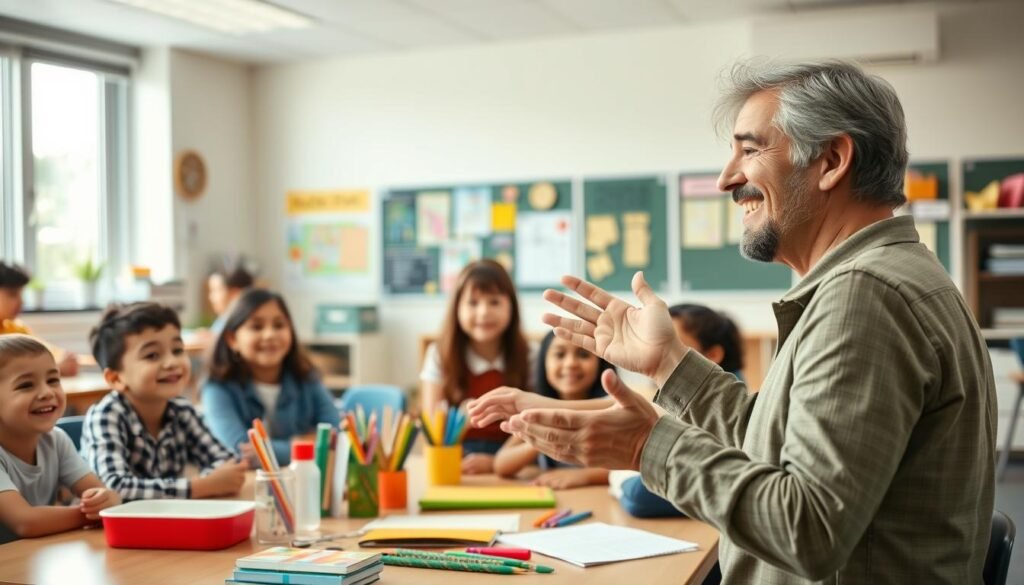Have you ever wondered how a simple shift in teaching strategies can transform a learning environment? Modern classrooms are moving away from traditional punishment methods and embracing recognition-based approaches. This change is rooted in B.F. Skinner’s operant conditioning, which emphasizes rewarding desired behaviors.
Recent studies, including the 2024 PBIS research, show a 22% reduction in disruptions and an 18% boost in academic achievement when these techniques are applied school-wide. Effective implementation often starts with proper teacher training, like the M.S.Ed. program at YSU, which focuses on brain-based learning and behavior management.
By adopting these strategies, educators can foster a more engaging and supportive atmosphere. This not only improves classroom culture but also enhances academic performance. Ready to explore how you can make this shift in your teaching?
Key Takeaways
- Modern classrooms focus on recognition over punishment.
- B.F. Skinner’s operant conditioning is the foundation.
- PBIS data shows a 22% drop in disruptions.
- Teacher training is key for effective implementation.
- These methods boost engagement and academic success.
What is Positive Reinforcement in the Classroom?
Behavior-focused strategies are reshaping modern education. Instead of focusing on what students do wrong, teachers are now emphasizing what they do right. This approach is rooted in the idea that recognizing specific desirable actions can lead to lasting change.
Definition and Core Principles
At its core, this method involves intentionally acknowledging good actions. The ABC model—Antecedent, Behavior, Consequence—helps teachers understand why certain actions occur and how to respond effectively. For example, if a student raises their hand to answer a question, the teacher might praise them immediately. This reinforces the desired behavior.
B.F. Skinner’s Theory of Operant Conditioning
B.F. Skinner’s work in 1953 laid the foundation for this approach. His experiments with rats showed that rewarding specific actions increases the likelihood of them being repeated. In classrooms, this translates to strategies like “catching them being good,” where teachers actively look for and acknowledge positive actions.
According to the US Department of Education, schools using these methods see 31% fewer suspensions. This highlights the effectiveness of focusing on good behavior rather than punishing bad actions. By creating a supportive learning environment, teachers can foster better outcomes for their students.
Why Positive Reinforcement is a Powerful Tool for Teachers
How can teachers create a more dynamic and effective learning space? Recognition-based strategies are a reinforcement powerful tool that can transform how students interact with their education. By focusing on what learners do well, educators can inspire greater engagement and drive better outcomes.
Benefits for Student Engagement and Motivation
When students feel acknowledged, their motivation to participate increases. A 2018 study found that 4th and 5th graders who received consistent recognition improved their test scores by 14%. This shows how small changes in teaching methods can lead to significant results.
PBIS schools report a 27% higher participation rate when these strategies are used. Teachers who frequently praise students for their efforts see a direct correlation with task persistence. This approach helps learners stay focused and committed to their goals.
Impact on Academic Performance and Classroom Culture
These methods don’t just boost grades; they also shape the learning environment. In one urban middle school, the introduction of recognition-based strategies led to a noticeable shift in classroom culture. Students became more supportive of one another, and disruptions decreased.
Emotional benefits are also significant. At-risk students experienced a 33% reduction in anxiety when their efforts were consistently acknowledged. This highlights the importance of creating a positive classroom where every learner feels valued.
- Improved test scores by 14% in 4th and 5th graders.
- 27% higher participation rates in PBIS schools.
- 33% anxiety reduction in at-risk students.
- Enhanced empathy and social-emotional learning outcomes.
Types of Positive Reinforcement Strategies
What makes certain teaching methods more effective than others? The answer often lies in the type of strategy used. Educators can choose from tangible, social, or activity-based approaches to encourage good behavior. Each method has unique benefits and works best in specific situations.
Tangible Reinforcers: Stickers, Tokens, and Prizes
Tangible rewards like stickers, tokens, or small prizes are popular in many schools. These items give students something physical to work toward. For example, a token system can increase compliance by 40%, according to the Journal of At-Risk Issues.
Digital tools like Kodable, which uses badges, have also shown success. They boost STEM participation by 22%. However, it’s important to avoid over-reliance on food or candy as incentives.
Social Reinforcers: Verbal Praise and Nonverbal Gestures
Social rewards, such as verbal praise or a thumbs-up, are simple yet powerful. They help students feel valued and recognized. Younger learners often respond well to this approach, while older students may prefer more subtle gestures.
These methods are cost-effective and easy to implement. They also foster a sense of community in the learning environment.
Activity-Based Rewards: Free Time and Special Privileges
Activity-based rewards, like extra free time or leadership roles, motivate students by offering unique privileges. These incentives work well across age groups. For instance, younger students may enjoy extra playtime, while older ones might appreciate being class monitors.
PBIS-tiered systems often include these rewards to encourage school-wide participation. They create a structured yet flexible approach to behavior management.
How to Implement Positive Reinforcement in Your Classroom
The key to success lies in identifying and rewarding the right behaviors. By following a structured approach, teachers can create a supportive and engaging learning environment. Here’s how to get started.
Step 1: Identify Desired Behaviors
Start by defining specific actions you want to encourage. Use observable and measurable criteria to ensure clarity. For example, raising hands before speaking or completing assignments on time are clear goals. A template can help streamline this process.
Step 2: Choose Appropriate Reinforcement Methods
Match rewards to student demographics and preferences. Younger learners may respond well to stickers, while older students might prefer privileges like extra free time. A decision matrix can guide this selection.
Step 3: Create a Consistent Reward System
Consistency is crucial for success. Use a fixed or variable ratio schedule to reinforce desired behaviors. For instance, the “Effort Bucks” system reduced off-task behavior by 62% in a high school study. Digital tools like token trackers can simplify this process.
Step 4: Provide Timely and Specific Feedback
Immediate recognition reinforces actions effectively. Use phrases like “I noticed you worked hard on this” to give specific feedback. A 5:1 praise-to-correction ratio optimizes the learning climate and builds trust.
By following these steps, teachers can foster a supportive environment that encourages growth and engagement. The right strategies make all the difference.
Positive Reinforcement vs. Punishment: Key Differences
Understanding the impact of different teaching approaches can shape student success. Recognition-based strategies and punishment methods have distinct effects on behavior and emotional well-being. While one fosters growth, the other can lead to unintended consequences.
Comparative Effects on Behavior and Emotional Well-being
Recognition-based methods activate dopamine pathways in the brain, encouraging repeated positive actions. Punishment, on the other hand, triggers a fear response, which can harm emotional well-being. Studies show that schools using recognition strategies see fewer disciplinary issues and healthier peer interactions.
Neuroscience reveals that dopamine-driven rewards enhance motivation and engagement. Fear-based approaches, however, can increase anxiety and reduce trust in the learning environment. This highlights the importance of choosing methods that support long-term growth.
Long-Term Outcomes in Classroom Management
OSEP data shows that PBIS schools maintain behavioral gains for over three years. In contrast, punishment correlates with a 28% higher dropout rate. This underscores the value of sustainable systems that prioritize recognition over discipline.
Longitudinal studies reveal that recognition-based approaches improve retention rates and reduce disciplinary referrals. Schools that invest in these methods create a supportive environment where students thrive. Administrators often note the cost-effectiveness of such systems compared to managing frequent disruptions.
- Dopamine pathways enhance motivation, while fear responses hinder it.
- PBIS schools maintain gains for over three years.
- Punishment leads to higher dropout rates and increased anxiety.
- Recognition-based systems reduce disciplinary referrals and improve retention.
- Case studies show contrasting outcomes in schools with different approaches.
Addressing Challenges in Using Positive Reinforcement
What hurdles do educators face when implementing behavior-focused strategies? While these methods are effective, they come with their own set of challenges. From maintaining consistency to ensuring fairness, teachers must navigate these obstacles to create a supportive learning environment.
Common Pitfalls and How to Avoid Them
One major issue is inconsistency in applying rewards. Studies show that 68% of new teachers struggle with this. To address this, use tools like weekly reward audits to track progress. Another pitfall is over-reliance on tangible rewards, which can lose their effectiveness over time. Instead, mix in social and activity-based incentives to keep students engaged.
Equity is another concern. Teachers must ensure that all students, including those with IEPs or 504 plans, feel included. Differentiation strategies can help tailor rewards to individual needs. For example, student-led committees in upper grades can promote a sense of ownership and fairness.
Ensuring Fairness and Consistency in Reward Systems
Fairness is critical for the success of any reward system. The “Mystery Motivator” technique, where students earn surprise rewards, increases perceived fairness by 41%. This approach keeps students motivated and reduces bias.
Consistency is equally important. Calibration techniques, such as weekly reviews of reward distribution, help maintain balance. Teachers should also communicate clear criteria for earning rewards to avoid misunderstandings.
By addressing these challenges, educators can create a system that is both fair and effective. This fosters a positive learning environment where every student feels valued and motivated to succeed.
Positive Reinforcement Across Different Age Groups
How do teaching strategies evolve to meet the needs of different age groups? Educators must tailor their approaches to suit the developmental stages of their learners. What works for young children may not resonate with older students. Understanding these differences is key to creating effective learning environments.
Strategies for Early Childhood Education
In early childhood, visual and sensory methods are highly effective. For example, token boards can help young children understand expectations. These tools improve transition times by 74%, making daily routines smoother.
Sensory rewards, like extra playtime or tactile activities, also work well. These methods align with the developmental needs of younger learners. Teachers can use these strategies to build foundational skills in a fun and engaging way.
Adapting Techniques for High School Students
For high school students, more sophisticated approaches are needed. Programs like “Flex Friday,” which reward homework completion with free time, increase participation by 53%. This shows how older students respond to incentives that align with their interests.
Another example is GPA-based parking privileges. These rewards motivate students to maintain academic performance. Cross-age mentorship programs also foster leadership skills while reinforcing positive behaviors.
Tech tools like Classcraft can engage older learners by gamifying the learning experience. These adaptations ensure that strategies remain relevant and effective across all age groups.
Conclusion: Building a Positive Classroom Environment
Creating a supportive space for students starts with intentional strategies. Research shows that methods like recognition-based systems can transform the learning environment. YSU program graduates report an 89% satisfaction rate with these techniques, proving their effectiveness.
Start small. Choose one strategy to implement today. Whether it’s verbal praise or activity-based rewards, consistency is key. Over time, these efforts will foster a more engaging and productive space for teaching and learning.
For professional development, consider programs like YSU’s M.S.Ed. or resources from PBIS.org. These tools can enhance your work and help you build a stronger connection with your students.
One teacher shared how using a token system reduced disruptions by 60% in just three weeks. Small changes can lead to big results. Begin your journey toward a more supportive positive classroom now.
FAQ
What is positive reinforcement in an educational setting?
It’s a method where desired actions are encouraged through rewards or recognition. This approach helps students repeat good behavior and improves their engagement in learning activities.
How does positive reinforcement benefit students?
It boosts motivation, enhances academic performance, and fosters a supportive learning environment. Students feel valued and are more likely to participate actively.
What are some examples of tangible reinforcers?
Stickers, tokens, and small prizes are common tangible rewards. These items can motivate students to achieve specific goals or complete tasks effectively.
How can teachers use social reinforcers effectively?
Verbal praise, thumbs-up gestures, or written notes of appreciation can reinforce good behavior. These methods build confidence and encourage peer recognition.
What are activity-based rewards, and how do they work?
These include extra free time, special privileges, or fun activities. They reward students for completing tasks or demonstrating consistent effort.
What steps are involved in implementing positive reinforcement?
Teachers should identify desired behaviors, choose suitable rewards, create a consistent system, and provide timely feedback to ensure success.
How does positive reinforcement differ from punishment?
While punishment focuses on discouraging bad behavior, reinforcement encourages good actions. It creates a more supportive and motivating atmosphere for learners.
What challenges might teachers face with positive reinforcement?
Common issues include inconsistency, fairness concerns, and over-reliance on rewards. Teachers should plan carefully to avoid these pitfalls.
How can strategies be adapted for different age groups?
Younger children may respond well to stickers and praise, while older students might prefer privileges or recognition for their achievements.









